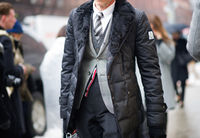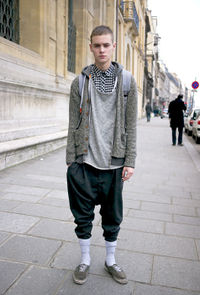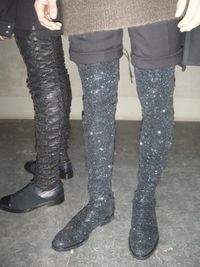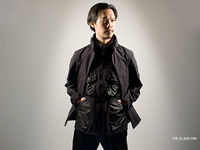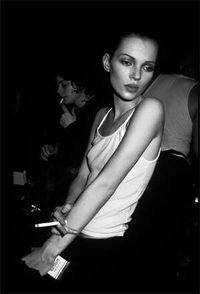Difference between revisions of "Styles"
(tumblrcore --> purgatory) |
(re-added heroin chic by popular demand, sieg if you feel it shouldn't be there, pls provide an explanation on the talk page, ty) |
||
| Line 93: | Line 93: | ||
<br /> | <br /> | ||
<br /> | <br /> | ||
| + | |||
| + | |||
| + | ==Heroin Chic== | ||
| + | [[File:chic.jpg|200px|thumb|right]] | ||
| + | '''Examples of Brands: [[Dior Homme]] (Hedi Era) mainly, but anything skinny and black applies''' | ||
| + | |||
| + | Heroin chic became popular in the 90's, and it's where ex-Club Kids went to die. Starting with Calvin Klein's campaign featuring Kate Moss, and Vincent Gallo shooting emaciated, drug-addicted looking models, it was quickly devoured as the hottest style. Heroin prices were dropping and the purity was much better at the time, which helped increase it's popularity. | ||
| + | The style was dead in the magazines when in 1999, Gisele Bundchen was dubbed the new supermodel. Nowadays, it carries on in fashion, though with a much lighter tone thanks to our teenagers who insist on dying due to anorexia and make Heroin Chic look evil. | ||
| + | |||
| + | It is more about the body than other styles; you can't be Heroin Chic while looking perfectly healthy and/or plump. First stages of anorexia are preferred, since it's a matter of looking glamorous while feather thin, not dirty and sick. Dark circles under the eyes are a bonus, and you need to appear like an elegant trainwreck. | ||
| + | <br /><br /><br /><br /><br /><br /><br /><br /><br /><br /><br /> | ||
== Transition to a Style == | == Transition to a Style == | ||
At some point in time, you may decide to make a switch from basic wear to a new style, or perhaps from one style to another. It is important to thoroughly consider the choice to switch; one should avoid making a switch without wholeheartedly deciding that the new style is a reflection of his/herself. Oftentimes, the aforementioned styles include pieces that "overlap," so to say, with basic wear. | At some point in time, you may decide to make a switch from basic wear to a new style, or perhaps from one style to another. It is important to thoroughly consider the choice to switch; one should avoid making a switch without wholeheartedly deciding that the new style is a reflection of his/herself. Oftentimes, the aforementioned styles include pieces that "overlap," so to say, with basic wear. | ||
Revision as of 18:27, 2 June 2013
--Any information on a certain style goes here. The history of a style is also welcome.
Contents
A Small Note on Styles
If you haven't read the introduction, do it now. This page is for different styles, not only in fashion, but in life itself. Many people disreguard their day-to-day life when attempting a new style, and this is where they fail. Be concise when looking for your ideal style. Don't be a try-hard, don't be an actor.
Please Note: Categorizing fashion into "styles" like they were animals in a taxonomy, while convenient for the beginner, is actually a bad view to adopt. Outfits cannot be "categorized" into styles completely because each one is unique, and many deviate from these supposed "styles". Styles are not objective. For more information on developing your personal style, see section 1 of the Introduction.
Traditional
Examples of Brands: Thom Browne, Tom Ford, Isaia, Brioni, Ralph Lauren Purple Label, Martin Greenfield, Calvin Klein Collection
Menswear is a modernized style that draws from conservative or classical male working aesthetic. Masculine silhouettes, formal incorporated into casual attire, and somewhat preppy styles fall here. Fit and fabric in the outfit serves great importance in Menswear outfits, as well as controlling the quality of the clothing you purchase. Cheaply made, ill fitting Menswear is a recipe for disaster, as it's very easy to come off as sloppy or trashy. Keeping this in mind, a crisp tailored button-down, slim-fitting trousers, a pair of casual oxfords, and a relatively casual tie, for example, can be worn to either a job interview or a night on the town.
In the debates that take place on /fa/ and elsewhere, styles are often given names by their opponents to mock and ridicule its followers. The derogatory term used to describe menswear is "Dadcore". As the style's classical aesthetic is associated with the older generations (as in being "clothes for dads") menswear has been mocked as such. However the nickname has since turned into the term used for failed attempts at menswear, which includes the wearing of fedoras, ill fitted suits and general bad taste. Menswear is difficult to pull off if under the age of 25.
Clothing in this type of style highly emphasis construction, material quality and difficult pattern-making work. Such examples are the obsession with Loro Piana cashmere and often regarded as the best wool in the world Ermengildo Zegna, and a emphasis on Bespoke labels and construction techniques.
Difficult pattern making/finishing work as seen on the skeleton style lining of Oxxford brand bespoke suits.
Streetwear
Examples of Brands: Supreme, White Mountaineering, A Bathing Ape, Undercover, WTAPS, Visvim
Streetwear is usually regarded as the most flexible style on /fa/, with multiple possibilities and damn near anything can be called streetwear. Streetwear is mostly personal preference and has many forms, ranging from your typical snapback-wearing adorned "swaggot" (one obsessed with the concept of swag) to Japanese workwear. A good place to begin learning about streetwear is hypebeast and superfuture.
Streetwear can be described as practical, fit for everyday wear and even light physical activities. The general rule of thumb is that it cannot contain easily spoiled pieces, and is not unusual for typical big city setting.
Examples Gallery
Artisanal/Post-Glamour/post-Glam Rock Post-slimane Dior
Examples of Brands: Rick Owens, Yohji Yamamoto, Julius_7, Ann Demeulemeester, Maison Martin Margiela.
Artisanal styles are a much less accessible, niche aesthetic. The style is humerously referred to as "Goth-ninja" (taken from a misguided young woman in the summer of 2007 who made a blog post about her new found love of a rick owens show titled "crust" ) by those who oppose it, though this should not be mistaken for the appropriate term. The usual defining features of this style are grayscale color palette, unconventional proportions, in typically low quality fragile knits meant to tear and conform to the wearers body - but really, anything goes.
Common artisanal fads in the past were minimalism (late 90's), deconstruction (early-mid 00's), and now feminine/women's wear designs applied to meanswear pieces. (rick owens pioneered this with skirt jeans, heels and one shoulder strap tank tops shown in the men's and women's collections, Rick owens is considered to many UNI-SEX, as some men wear women's leather jackets and some women wearing men's wear from these collections)
Many pieces are made with unique techniques, treatment (ombre dip dyes, carol Christian poell leather dipped in latex rubber and let dry), and materials. A vast majority of "Artisnal" brands place a strong priority on being anti-branding, using minimalist logos on the interior of pieces, generally placing priority on the construction, form, and quality of the garment, above the brand that created it. (maison martin margiela is the only brand known to do this).
Many of the people who appreciate this aesthetic share the same appreciation for craftsmanship, modern design.
Urban Techwear
Examples of Brands: Acronym, Arc'teryx Veilance, Y-3, Gyakusou, Isaora, Outlier
Clothing designed for a specific purpose worn in a traditional sense, or as a fashion statement. (ex: outlier, meant for fixed gear cycling in city limits) A lot of the brands considered fashionable in this sort of setting are fashion designs collaborating with traditional sportswear brands, yohji yammamoto and addidas making up Y-3.
A lot of the clothing takes on a military look, (started with Christopher bailey's reintroduction of the military inspired aesthetic, many argue that it saved burberry prorsum). Arc'teryx LEAF and other military inspired clothing articles worn on the street.
Combines clothing with a sort of technical look: Many straps, pockets, zippers etc. Derives from common streetwear, but with the twist that it focuses on human interaction with the elements through technology. Smart fabrics, digital gadgets and the like are coupled with the clothes themselves. Many are also fit for out-of-city wear, such as in exploring natural settings and leaving city limits.
Examples Gallery
Heroin Chic
Examples of Brands: Dior Homme (Hedi Era) mainly, but anything skinny and black applies
Heroin chic became popular in the 90's, and it's where ex-Club Kids went to die. Starting with Calvin Klein's campaign featuring Kate Moss, and Vincent Gallo shooting emaciated, drug-addicted looking models, it was quickly devoured as the hottest style. Heroin prices were dropping and the purity was much better at the time, which helped increase it's popularity. The style was dead in the magazines when in 1999, Gisele Bundchen was dubbed the new supermodel. Nowadays, it carries on in fashion, though with a much lighter tone thanks to our teenagers who insist on dying due to anorexia and make Heroin Chic look evil.
It is more about the body than other styles; you can't be Heroin Chic while looking perfectly healthy and/or plump. First stages of anorexia are preferred, since it's a matter of looking glamorous while feather thin, not dirty and sick. Dark circles under the eyes are a bonus, and you need to appear like an elegant trainwreck.
Transition to a Style
At some point in time, you may decide to make a switch from basic wear to a new style, or perhaps from one style to another. It is important to thoroughly consider the choice to switch; one should avoid making a switch without wholeheartedly deciding that the new style is a reflection of his/herself. Oftentimes, the aforementioned styles include pieces that "overlap," so to say, with basic wear.
